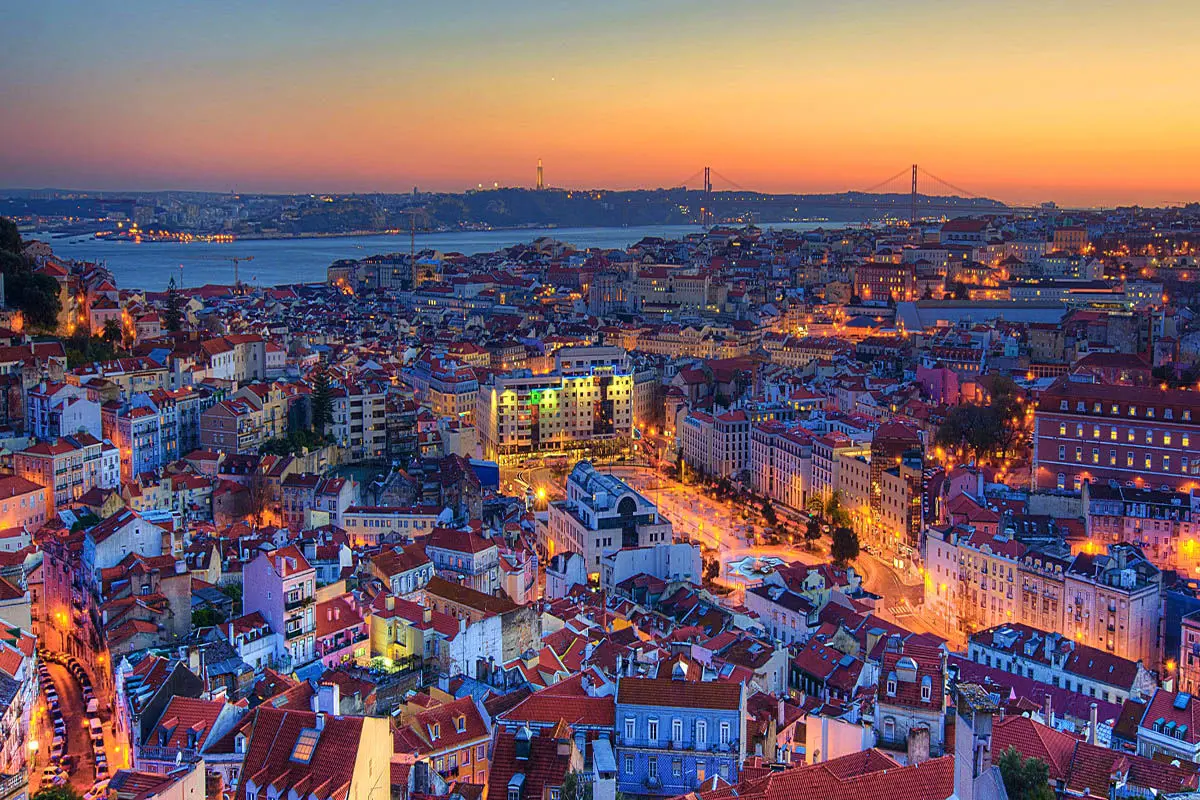
BELEM TOWER
This tower was built in 1515 in honor of the patron saint of Lisbon, Saint Vincent. Over time, it would become one of the most representative examples of Manueline architecture. Due to its strategic location at the mouth of the Tagus, it was first used as a defense tower to protect the entrance of the port. From this region, many explorers would roam the oceans in search of new lands and maritime routes in Asia, Africa and Americas.
Its use changed as the years passed. For a period it served as a customs office, then later as a jail to house political prisoners.
The tower is divided into five floors. On the first three, we can see with the audioguide (audioguides) the Governor's Hall, the Hall of the Kings and the Audience Hall. On the fourth and fifth floors are the Chapel and the Terrace.
The tower is accessed by a bulwark in which you can see various defensive cannons and the pits where the prisoners were thrown. Its interior is decorated in an austere manner, with highlights including a sculpture of St. Vincent and another of the patron saint of travel.
On the outside, we can see with the audioguide (audioguides) its open galleries and the protective design of its watchtowers and battlements, one of which is adorned by a rhinoceros statue.
Before construction of the tower began, the governor of Portuguese India presented King Manuel I with a living rhinoceros. Upon arriving in Lisbon, the exotic animal aroused great interest among the local population, unsurprising considering it was the first rhinoceros on European soil for more than a thousand years. The famous stone statue was built to honor this moment in the city’s history.
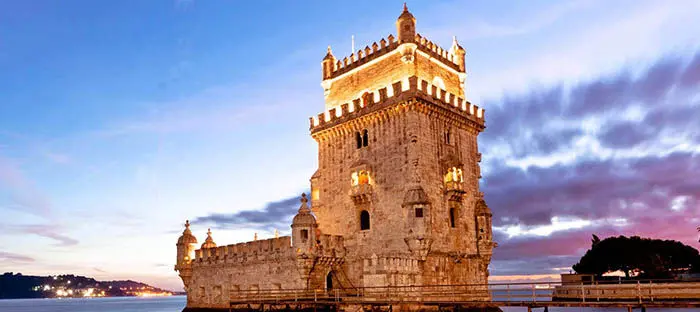
THE DISCOVERY MONUMENT
This monument was erected in 1960 to commemorate the 5th centenary of the death of Henry the Navigator, who was the discoverer of the Azores, Madeira, and Cape Verde.
The 52-meter monument has a caravel shape. In the bow, you can see with the audioguide (audioguides) Henry the Navigator as he inspires other Portuguese explorers to undertake later expeditions. In total, 33 personalities from the Age of Discovery appear here such as Vasco de Gama and Fernando de Magallanes.
On one side we have the Portuguese coat of arms. Presiding over the entrance is a representation of the Sword of the House of Avís. The latter is included because King Manuel I was a great patron of 16th-century exploration.
You can enter inside and climb upstairs to a lookout, from where there are sweeping views of the Belém neighborhood.
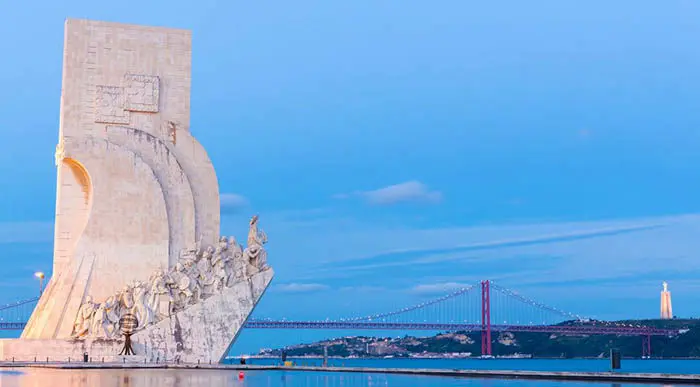
JERÓNIMOS MONASTERY
King Manuel I ordered architect Diogo de Boitaca to construct the monastery in 1501. The architect chose the Manueline style to honor Vasco de Gama, who had recently arrived from a trip to the Indies. In the site of the monastery lay the Hermitage of Restelo, which Henry the Navigator founded to provide Vasco de Gama and his crew a place to stay before embarking on their crusade. Construction was paid for using the profits obtained from the spice trade.
The Monks of the Order of Saint Jerónimo were the first residents and lived there until the 19th century when many religious orders were dismantled. Later, the monastery would pass into the hands of the Portuguese State.
Within the convent, we can find with the audioguide (audioguides) decorations with numerous maritime and sailing elements which serve as a reminder of its origin. The monastery houses the remains of Vasco de Gama and the poet Luís de Camões. Also, the chapel of the church is home to the tombs of several Portuguese monarchs such as Manuel I and his family, Sebastian I, Catherine of Austria, and Enrique I.
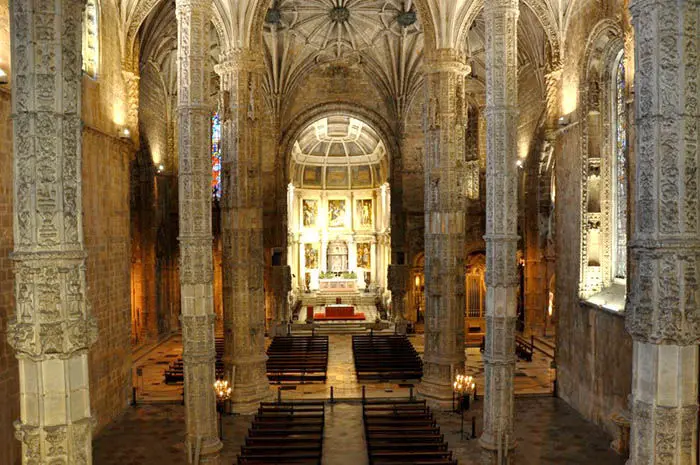
NATIONAL ARCHEOLOGY MUSEUM
This museum is located in the west wing of the Jerónimos Monastery, where the monks' dormitories once were.
The first director of the museum, José Leite de Vasconcelos, founded the collection in 1893 by donating his entire private collection. Due to a steady stream of donations over the years, it now houses the most extensive and important archaeological collection in Portugal. Exhibits range from the Paleolithic period through the Egyptian and the Classical. On display are artifacts from the Arab world to the Middle Ages.
Follow the audioguide (audioguides) to discover the highlights of the museum:
1. An Egyptian room where we can see sarcophagi, masks, talismans, the mummified remains of people and animals, stelae and vessels related to funerary rites, as well as a collection of historic photographs.
2. A room representing the Roman presence in Portugal with capitals, funerary stelae, and ceramics.
3. The Hall of Treasures which houses the most complete golden artifact collection of Portugal, covering several historical stages starting from the 6th century BC.
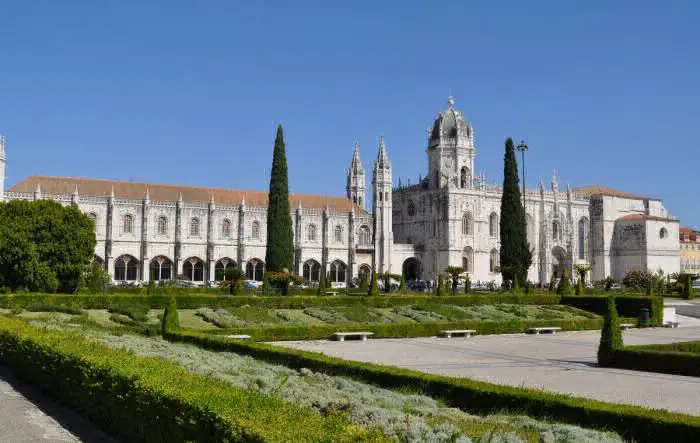
25th OF APRIL BRIDGE
Next interesting place of the audioguide (audioguides), at 2,277 meters, this is the longest suspension bridge in Europe and the first to be built in Lisbon of this type.
It was inaugurated in 1966 under the name of Salazar Bridge. However, after the Carnation Revolution of April 25, 1974, it was renamed to honor the event.
The bridge has two platforms of different heights. One is to house vehicular traffic, while the other, which was added later, is for the passage of trains.
People often compare or even confuse this bridge with the Golden Gate Bridge of San Francisco. The same construction company undertook both projects so they share many similarities.
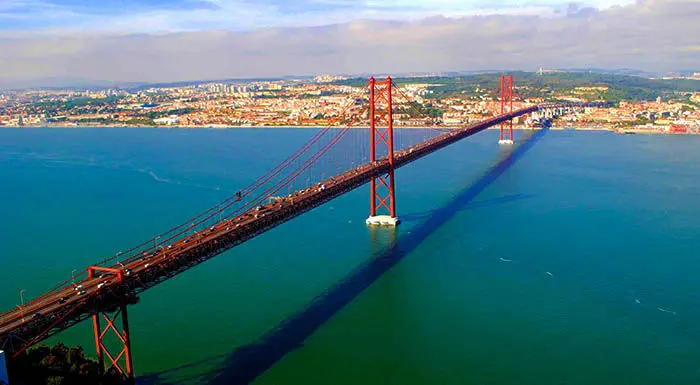
COMMERCE SQUARE
Known as the Praça do Comércio in Portuguese, this is the most important square in Lisbon, serving for many years as the primary entry point of maritime trade. The square was built over the former site of the Royal Palace, which was destroyed by the great earthquake of 1755.
The Commerce Square is surrounded on three sides by a series of buildings with large windows. The southern side overlooks the Tagus River, where ships enter and leave.
You can see wih the audioguide (audioguides) two points of interest that stand out in the square.
A bronze equestrian statue of King José I, who was in charge of the city during the earthquake of 1755.
And the Rua Augusta Arch, which was raised to commemorate the reconstruction of the city after the great earthquake. It was completed in 1873 and features statues of Vasco da Gama, the Marquis of Pombal, and Nuno Álvares Pereira. The arch can be found on Rua Augusta, the most important street in the Baixa neighborhood.
In the upper section, we see allegories of the Glory, the Genius, and the Value with a Latin inscription that reads, "To the virtues of the Greatest so that it serves as a lesson to all. Dedicated to the public treasury."
Since its reconstruction, the plaza has been the scene of many important historical Portuguese events. Examples include an attack against King Carlos and his son Louis Philip at the beginning of the 20th century and the military uprising of 1974 during the Carnation Revolution that overthrew the Salazar regime.
In addition, citizens and tourists meet here each New Year's Eve to welcome in the New Year with fireworks and shots of ginjinha, a typical local drink made with cherries, alcohol, and sugar, among other ingredients.
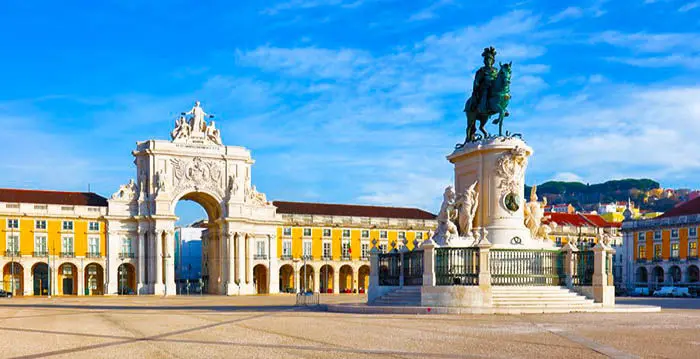
THE LISBON CATHEDRAL
This is the oldest church in the city. Construction began in the 12th century over the top of an old mosque after the city had been reconquered during the Second Crusade.
The church is commonly known as Sé de Lisboa, which comes from the initials S.E. of Episcopal See. Its original name, however, is Santa María Maior.
Both the interior and exterior of the building have been damaged on several occasions throughout its history. However, the great earthquake of 1755 caused the extreme havoc, leaving several sections of the structure utterly destroyed.
A series of excavations were carried out during the restoration effort. As a result, workers discovered numerous Roman and Arab remains which date back to before the original construction.
The remains of Saint Vicente, the patron saint of the city, are kept inside. We can also find with the audioguide (audioguides) treasures such as a collection of jewels, religious costumes, images, manuscripts, and relics related to the saint.
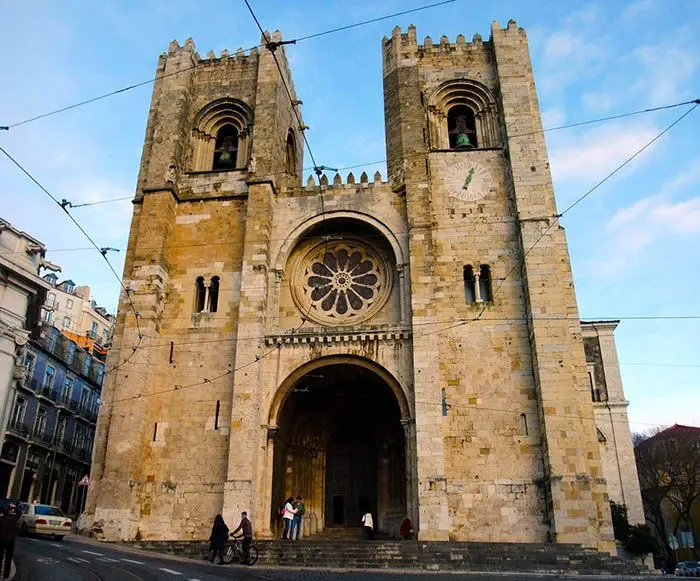
SAINT GEORGE CASTLE
The castle is located on the top of the Saint George Hill, which is the highest in Lisbon.
It was built in the 5th century by the Visigoths, but the excavations of Phoenician, Greek, and Carthaginian remains have shed more light on its past.
The Arabs extended the castle in the 9th century. The Muslim fortification was again reconquered in the mid-12th century by the first king of Portugal, Alfonso Henriquez, with the help of the Crusaders. The name was given in honor of the martyr Saint George, of whom the Crusaders had professed their devotion.
From then until the 16thcentury, the castle was the residence of Portuguese royalty, which coincided with a period of magnificent splendor. It has since been the scene of significant historical events such as the reception of Vasco de Gama upon his return from India.
After the great earthquake of 1755, the castle lay in ruins. It wasn’t fully restored until 1938.
Inside the complex are a collection of regional artifacts, the remains of different periods of the castle's history, and a periscope room which allows visitors to gaze on the city in real time in a 360º view with the audioguide (audioguides). Tourists can also enjoy excellent city views from the numerous castle towers, the most interesting of which is the Tower of Ulysses that houses a periscope built by Leonardo Da Vinci. The gardens are home to a prominent Portuguese species of native trees.
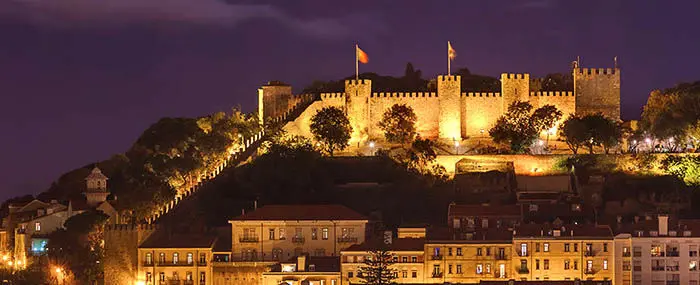
NATIONAL PANTHEON
The building was initially known as the Church of Santa Engráci. Construction began in the late 17th century and wouldn’t end until 1966.
The 285 years that it took to build the church led the Portuguese to coin the expression an “Obras de Santa Engrácia," (A Project of Santa Engráci) which refers to something that never ends.
A 16th-century church once stood on the site, although nothing remains of the original structure.
The building became a national pantheon at the beginning of the 20th century. Within it are the remains of famous Portuguese characters such as the actress Amália Rodrigues, and the Portuguese presidents Teófilo Braga and Manuel José de Arriaga Brum. It also contains the cenotaphs of other great characters such as Vasco de Gama and Luís de Camões, both of whom are buried in the Jerónimos Monastery.
The highlight of the structure is its great white dome which is decorated with various shades of marble. You can climb to the top with the audioguide (audioguides) to enjoy panoramic views of the city.
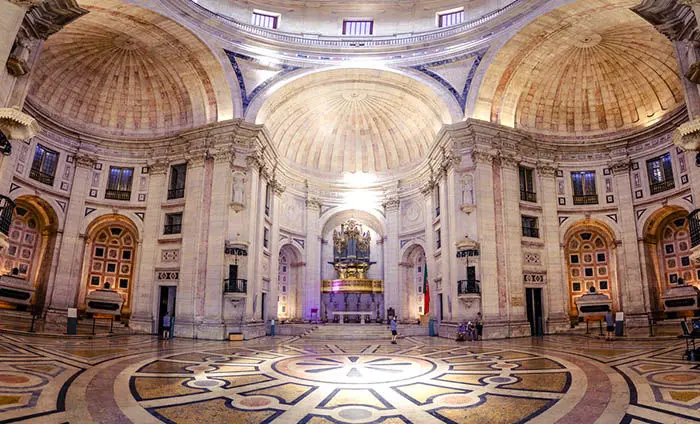
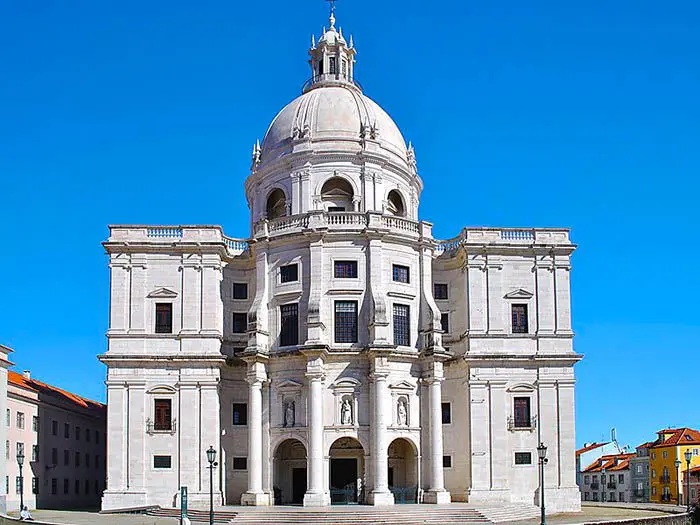
MARQUIS OF POMBAL SQUARE
This square is considered the starting point of the new Lisbon and the center of the new city.
It was built in tribute to Marquis of Pombal, who was Prime Minister during the reign of King José I, and the governor of Lisbon between 1750 and 1777.
Right in the center of the square stands a statue of Marquis along with a lion at the top of a column, which is a symbol of power. Below we can see with the audioguide (audioguides) allegorical images representing his educational, political, and agricultural reforms. We can also see broken stones and waves, which refer to his critical role in the reconstruction of the city after the earthquake of 1755.
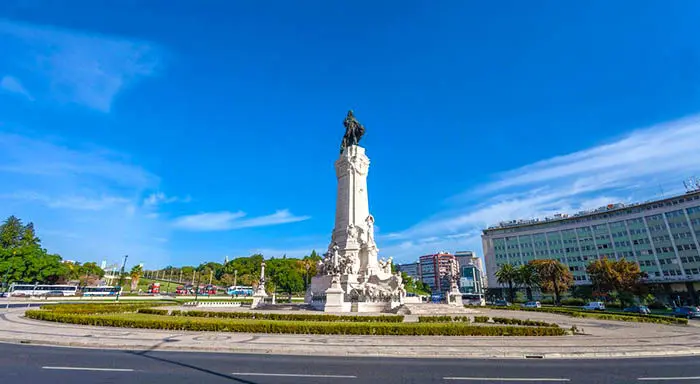
THE EARTHQUAKE OF 1755
On November 1, 1755, the people of Lisbon were celebrating mass throughout the city’s numerous churches, convents, and oratories. Suddenly, an earthquake measuring 8.5 on the Richter scale shook the entire city to its core.
Once the seemingly endless 6-minute quake had subsided, thousands of people lay entombed under the rubble, and hundreds of buildings had collapsed entirely.
What happened next was unimaginable. An hour and a half later, the survivors had gathered in Rossio Square when, without warning, a giant tsunami rolled in. The wave devastated the city once again and dragged countless souls out to sea.
During the night, the people of Lisbon placed candles around their houses to remember their dead, which is a custom on All Saints' Day. The earthquake caused these candles to topple which, in turn, resulted in a number of spot fires.
Strong winds caused the flames to spread which eventually engulfed much of the city in a deadly firestorm.
The great catastrophe took the lives of between 60,000 and 100,000 people. Bodies were merely tossed into the sea to avoid epidemic outbreaks, while the army and nearby towns were mobilized to help clear up the debris.
Architects and engineers were hired to aid in the clean-up effort. In less than a year, Lisbon was free of debris and reconstruction could begin. The new buildings erected in Lisbon were the first in the world to incorporate earthquake resistant techniques.
The audioguide (audioguides) of Lisbon continues in the next point.
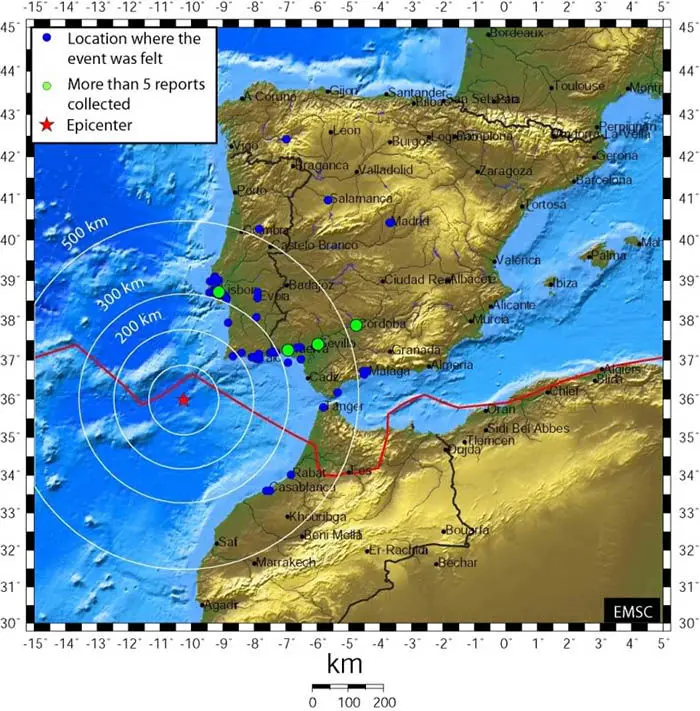
ROSSIO SQUARE
This square is most commonly known as Rossio which means, "public space.” However, its real name is Dom Pedro IV Square in honor of the Soldier King.
We are now with the audioguide (audioguides) in the Baixa neighborhood, at the northern end of Rua Augusta and in the neuralgic center of Lisbon. On each side of the square and throughout its nearby streets are the most famous shops, bars, and restaurants in the city.
In the center of the square is a statue of Pedro IV, the first emperor of Brazil and the Portuguese constitutional king. Its base is adorned with four feminine figures which represent the kindness of the king.
The square houses the Dona María II National Theater, which was built in 1842 to replace the old Estaus Palace, which was the seat of the Portuguese Inquisition since the mid-16th century. Adorning its neo-classical facade is a statue of Gil Vicente, who is considered to be the founder of Portuguese theater.
To the left of the National Theater is the Lisboa Rossio Railway Station. Built in 1887, the highlight of the station is its imposing façade.
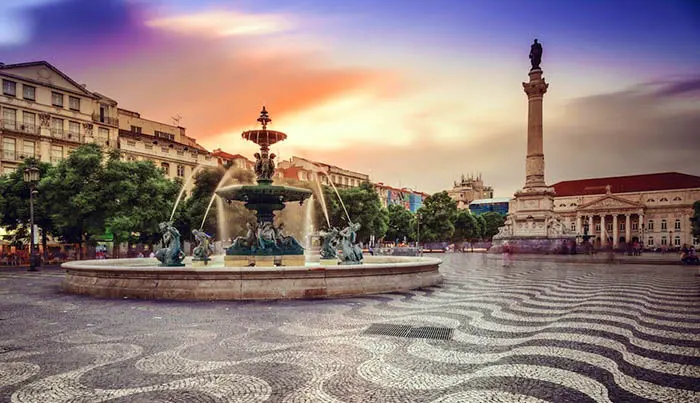
THE FADO MUSEUM
This museum is located in the Alfama neighborhood, where Lisbon’s famous nostalgic genre known as Fado was born and spread.
The museum opened its doors in 1998 upon gathering a unique collection of objects and stories related to the genre.
Inside the museum, we will learn with the audioguide (audioguides) the history of fado which began more than two centuries ago. We will also discover how it has transformed from numerous influences to evolve into the fado we know today.
The museum houses a collection of various musical items and instruments including the guitar, sheet music, photographs, posters, costumes, and trophies. It also contains detailed information on the history of great fado musicians, authors, and composers.
As a result, the Portuguese Association of Museology awarded the museum an Honourable Mention as one of the best Portuguese museums in 2009.
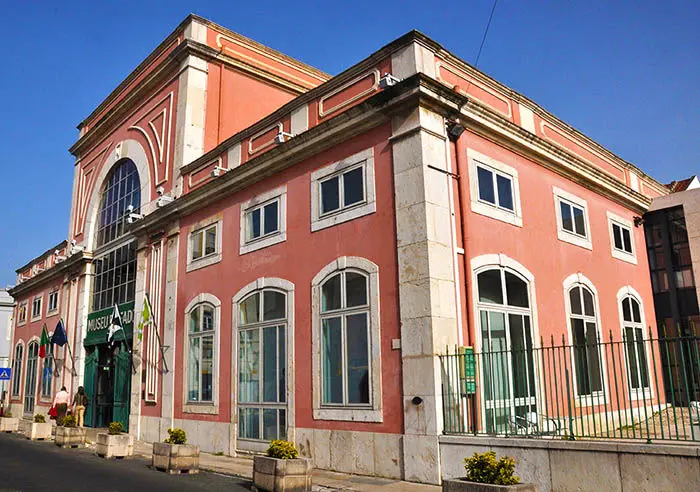
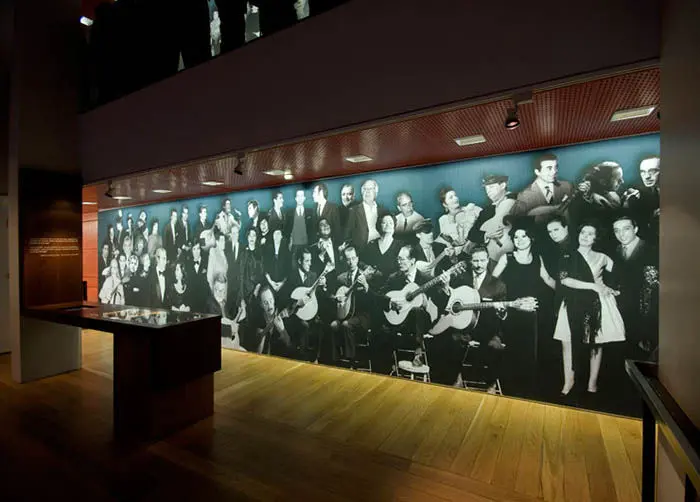
THE CARMO CONVENT
This was the most important Gothic temple in Lisbon until it was left in ruins by the great earthquake of 1755.
General Nuno Álvares Pereira ordered its construction, which took 34 years, to accommodate the order of the Carmelites. Upon completion, its founder, Fray Nuno de Santa María, moved inside until his death just a few years later.
After the earthquake of 1755, only a small portion of the church remained standing. The structure that we see today constitutes one of only a few existing examples of Medieval Portuguese architecture.
The convent, on the other hand, remains relatively unscathed. Inside, it houses the Carmo Archaeological Museum, which tells the story of Lisbon, from prehistory to the Middle Ages.
The collection includes Paleolithic stone chippings, objects related to Neolithic funerary rituals, the Sarcophagus of the Muses of the Roman period, the 14th-century tomb of King Ferdinand I, and the tomb of Nuno Álvares Pereira
There is also a space dedicated to the collections of two of the most important Portuguese archaeologists of the 19th century, Possidónio da Silva and Januário Correia de Almeida. Inside are Egyptian sarcophagi and South American mummies, that we can visit with the audioguide (audioguides).
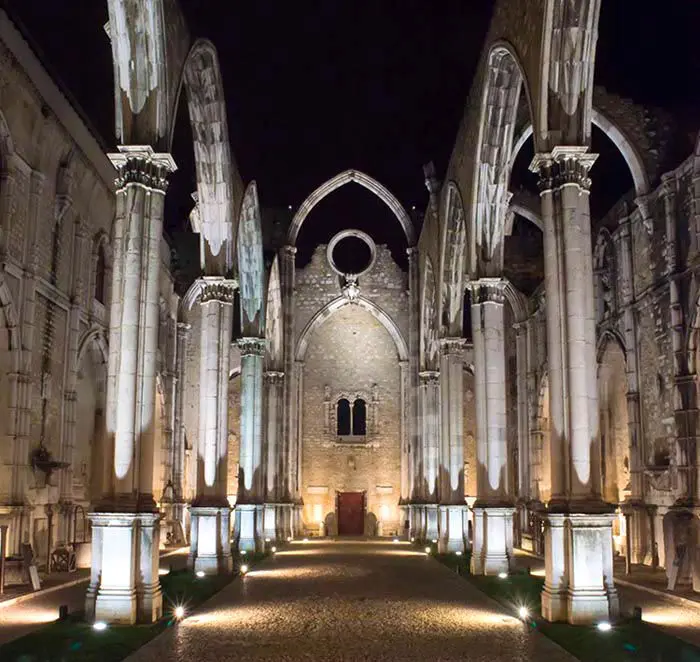
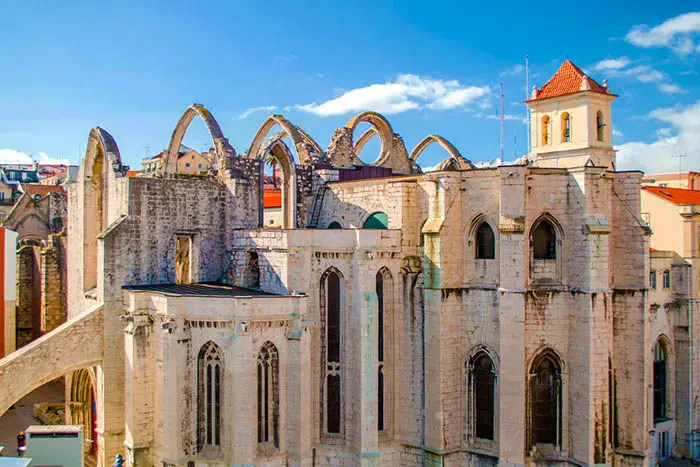
SANTA JUSTA LIFT
Also known as the Elevador do Carmo, this is the only vertical urban elevator in Lisbon that connects the Baixa and Chiado districts. These days, it is more of a tourist attraction than public transport.
The elevator was designed by Raoul Mesnier du Ponsard, an engineer who also designed Lisbon’s three funiculars. Upon opening in 1902, it was steam-powered, although it was later converted to run on electricity.
The 45-meter neo-Gothic style tower features an iron structure which is reminiscent of the Eiffel Tower. Inside are two polished wood elevators which bring tourists to a terrace at the top, from where you can enjoy spectacular city views with the audioguide (audioguides).
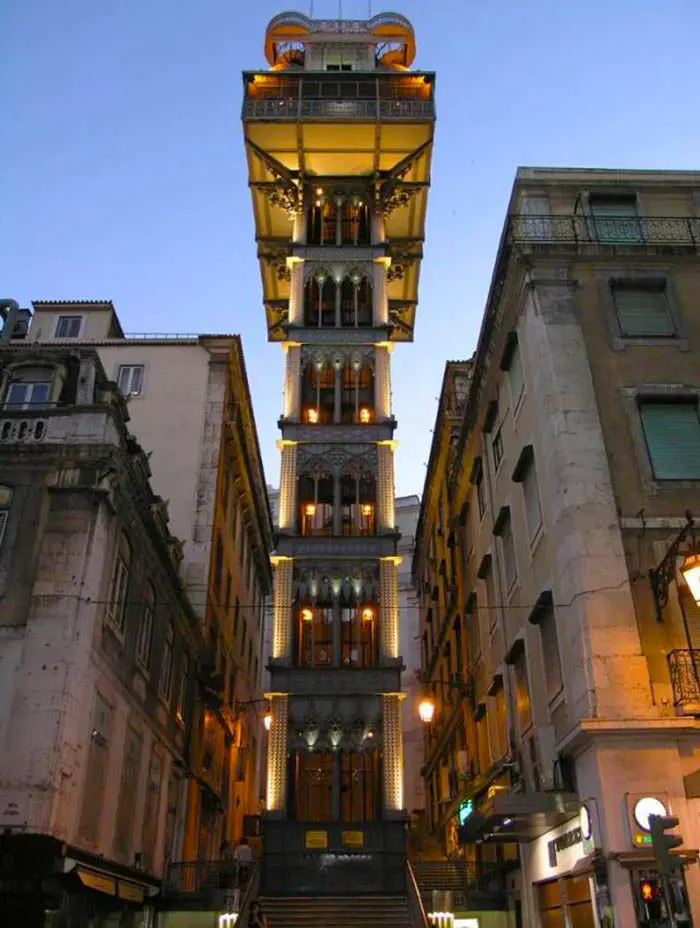
SANTO DOMINGO CHURCH
This 13th-century church was the largest in Lisbon for many years. It hosted all sorts of important religious ceremonies such as funerals, baptisms, and coronations.
Interestingly, the church has been the victim of numerous natural and manmade catastrophes throughout its history. It was practically destroyed by the tsunami that came after the great earthquake of 1755. After being rebuilt, a fire devastated its walls again in the middle of the 20th century. It took more than 6 hours to extinguish the blaze which claimed the lives of two firefighters
The church was rebuilt once again, but this time just the roof and the walls. Consequently, the building retains a partly fused and scorched appearance which we can still observe today with the audioguide (audioguides).
The interior of the church was the scene of a bloody massacre in January 1503. During mass one day, a recent Jewish convert to Christianity was praying with the other Christians, when a face which appeared similar to that of Christ suddenly lit up the church. Although the group adamantly proclaimed it a miracle, the convert was skeptical and argued it more likely to be a reflection from the sun. The Christians accused him of lacking faith and beat him to death.
Unfortunately, this was not an isolated incident. Enraged local Christians began persecuting the Jews and recent converts, eventually killing around 2,000 in the city.
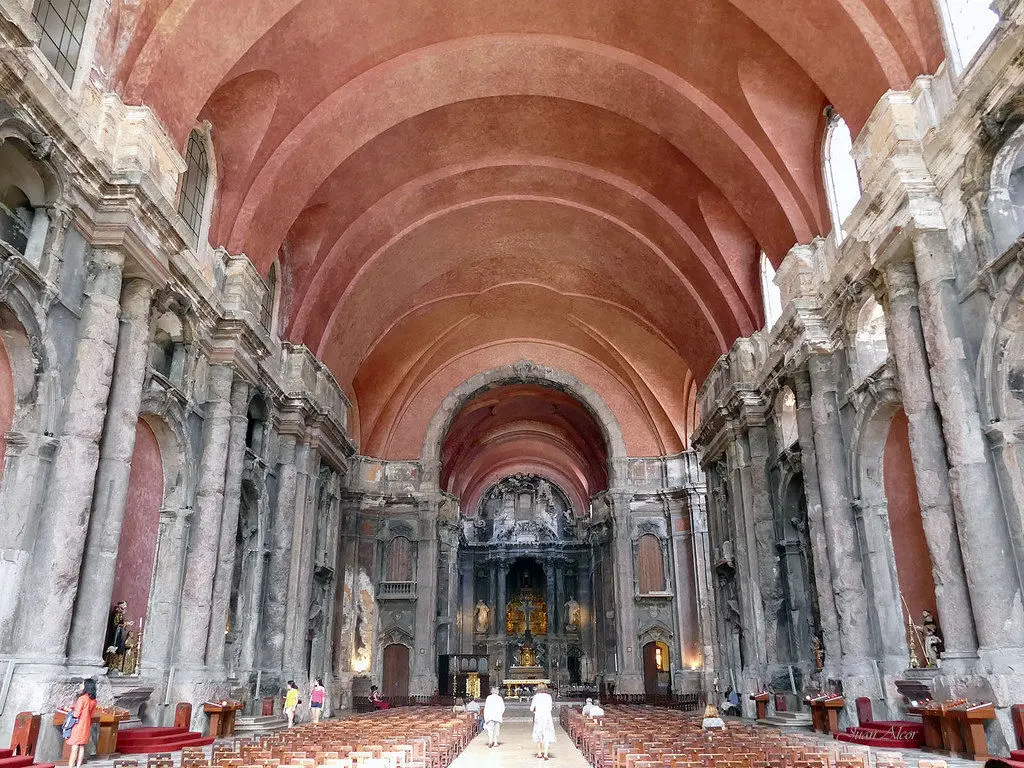
RESTAURADORES SQUARE
This square was built to honor the liberation of Portugal from the stranglehold of the Spanish in the 17th century.
In the middle of the square is a large obelisk which represents the moment independence was achieved in 1640 after sixty years of Spanish domination.
A number of victorious battles had rekindled Portuguese nationalism. As a result, all the names and dates of the battles of the Portuguese Restoration War have been engraved on the sides of the obelisk.
The country remained economically weak for some time and suffered from renewed invasion attempts. Nevertheless, in 1668 the Treaty of Lisbon was signed by which Spain recognized the sovereignty of their neighboring country.
For this reason, at the foot of the obelisk, we find with the audioguide (audioguides) two bronze figures, one representing the crowned Victory and the other representing Liberty.
Inside the square are a number of 19th-century buildings such as the old Eden Theater which has been converted into a hotel. Foz Palace is another highlight which currently houses the tourist office, the Condes Cinema building, and the Hard Rock Café.
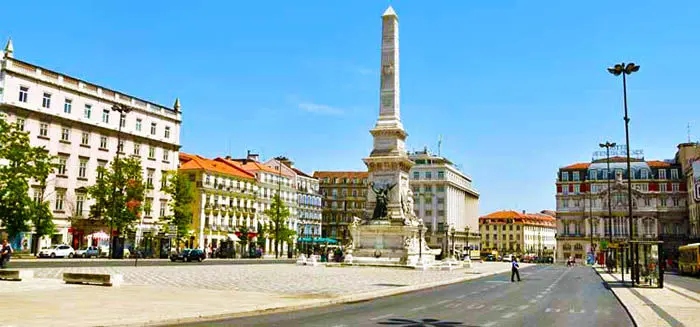
LAVRA LIFT
Next stop of this audioguide (audioguides), the funicular was inaugurated in 1884. Given that it is still in operation, it has become the oldest funicular in Lisbon with more than a century of use.
Originally it was steam-powered. However, over the years it has been modernized as electricity was eventually installed in the city’s tram network.
The exterior is decorated with tiles which feature drawings of various shapes and animals, including roosters.
Its tracks span a total of 188 meters, and the funicular can fit 22 seated passengers and another 20 standing.
Because it was free on its inauguration and all the locals wanted to take a ride, it transported over 3,000 passengers on its first day.
There are two other funiculars in Lisbon, the famous and fascinating Elevador da Glória and the more commonly used Elevador da Bica.
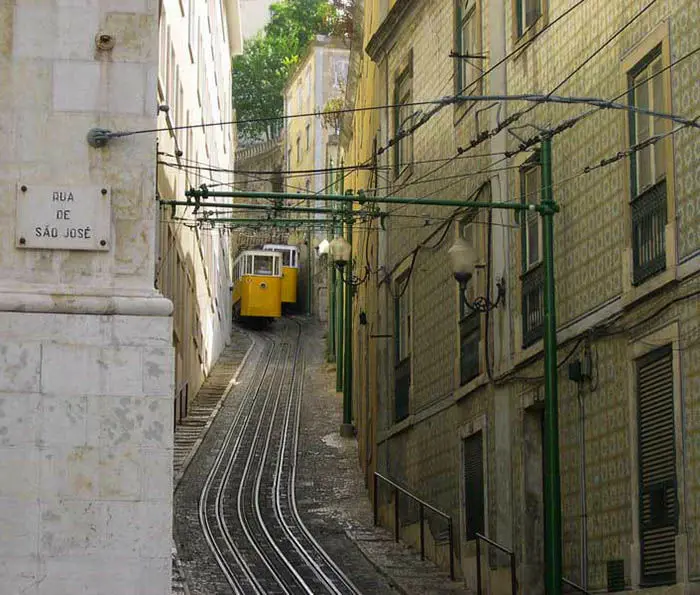
CASA DOS BICOS
This building faces the Tagus River in the Alfama neighborhood.
Its name comes from its façade which is made of stones carved in the shapes of diamond tips or peaks, known as bicos. Other notable elements are its doors and windows, all of which are unique.
The Casa dos Bicos is an old 16th century palace which belonged to Brás de Albuquerque. Bras was the son of Afonso de Albuquerque, the viceroy of India and a Portuguese conqueror who contributed substantially to the creation of the Portuguese Empire in the Indian Ocean.
In its early days, the palace was the seat in Lisbon of the Association of Maritime Trade with India. The upper part of the building collapsed during the earthquake of 1755. However, it was faithfully rebuilt thanks to images of the structure which had been preserved in old tiled murals and engravings.
The Albuquerque family sold the building in 1973. For a time it was used as a warehouse and as a trade center for cod fish. It currently houses the José Saramago Foundation, hosts various cultural events, and features a permanent exhibition about the life and work of the writer that you can visit with the audioguide (audioguides).
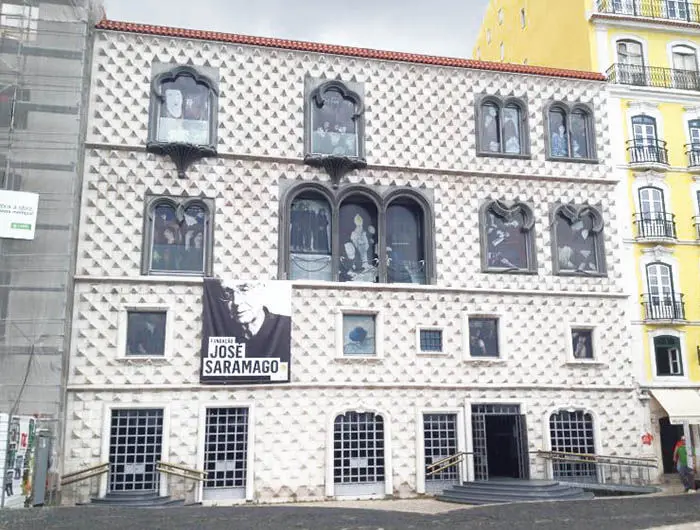
ESTRELA BASILICA
Queen Maria I ordered the construction of the Royal Basilica and Convent of the Most Sacred Heart of Jesus, which is the real name of the church. She promised to build a convent and a church for the nuns of the Order of Saint Teresa if divine intervention allowed her to give birth to a male child as her successor. Her prayers were answered when her son, José I Prince of Brazil, was born in 1761. However, construction didn’t start until 1779 due to a lack of funds. It was eventually completed in 1790.
The main facade is flanked by two identical bell towers which are decorated with statues of saints and allegorical figures. The highlight is its great dome that can be seen with the audioguide (audioguides) from various points around the city.
The interior of the basilica is decorated on the floor and the walls with marble, which forms different geometric patterns of gray, pink, and yellow.
The tomb of its founder, María I, lies within. There is also an interesting representation of the birth of Jesus by Machado de Castro. The work is comprised of more than 500 figures made of cork and terracotta.
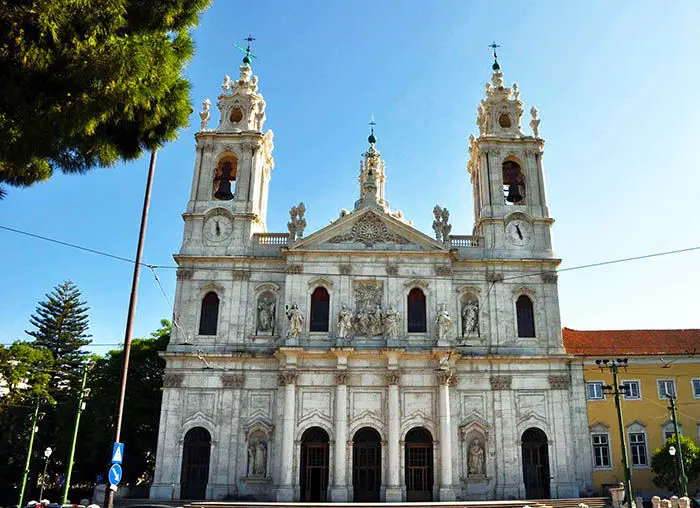
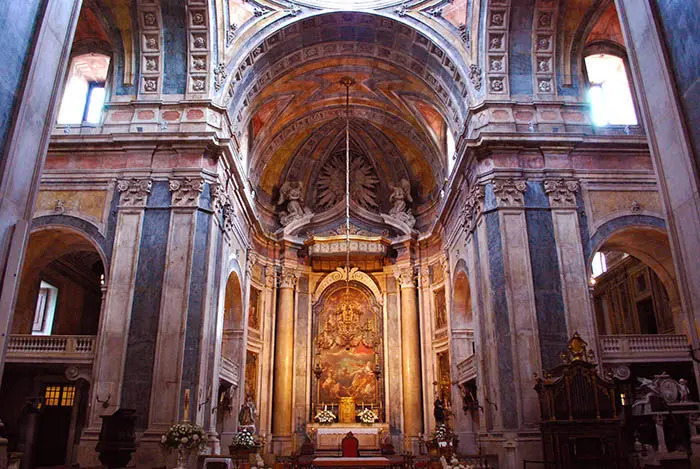
VASCO DE GAMA BRIDGE
We are now with the audioguide (audioguides) looking at the longest bridge in Europe, with a length of 12.3 kilometers. The Vasco de Gama Bridge was built for the Universal Exhibition of 1998, which is shown in its flag. It was baptized with the name of Vasco de Gama to commemorate the 500th anniversary of the arrival of the navigator to India in 1498, which is six years after Christopher Columbus discovered America.
The 25th of april bridge used to suffer from terrible traffic jams, thus the opening of this new bridge brought an enormous amount of relief.
The structure stretches up to 150 meters high. It is designed to withstand the impact of an earthquake up to four times greater than that which devastated Lisbon in 1755, as well as winds of up to 250 km/h.
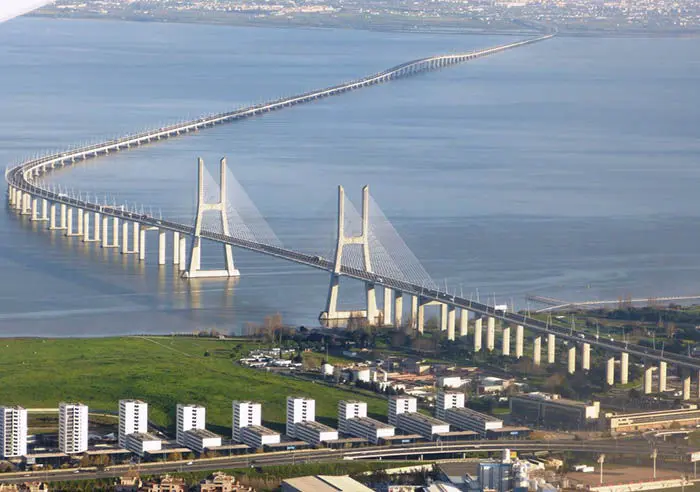
CHRIST THE KING
At more than 28 meters high, the Christ King of Lisbon is located at the entrance of the city to welcome both tourists and locals returning home.
This monument inevitably reminds us of the emblematic Christ the Redeemer of Rio de Janeiro, and with good reason. In 1934, the Cardinal of Lisbon traveled to Rio de Janeiro and was in awe as he gazed upon the Christ the Redeemer. Feeling inspired, he decided to raise funds to build a similar monument when he returned to Lisbon.
Construction was completed at the end of the fifties, symbolizing peace and gratitude towards God for having kept Portugal on the sidelines of the Second World War.
Its four pillars represent the cardinal points, and we will find the Chapel of Our Lady of Peace in its interior.
Inside is also an elevator that takes tourists up to a viewpoint where they can enjoy with the audioguide (audioguides) a panoramic view of Lisbon, with a range of up to 20 km in every direction.
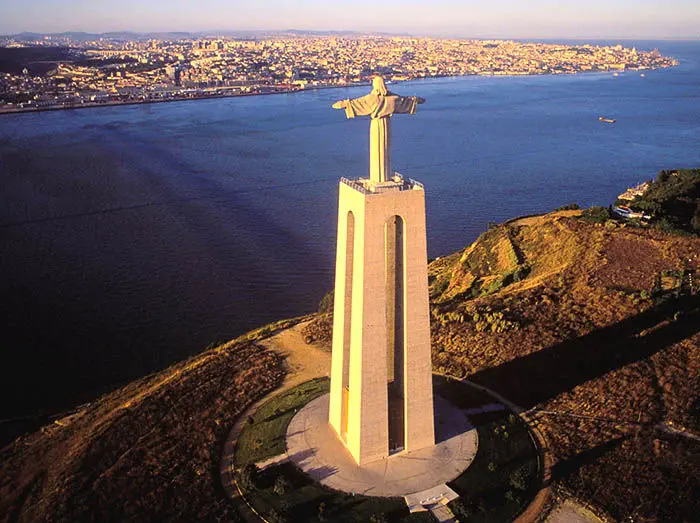
MARQUIS OF FRONTEIRA PALACE
This palace was the residence of the family of the first Marquis of Fronteira in the 18th century, and it is still the private residence of his descendants today.
The Marquis ordered the palace to be built in 1675 in Monsanto Park as a hunting lodge and summer residence. After the earthquake of 1755, he and his family were forced to move into this building because their normal residence had been destroyed.
Inside, each room is decorated with elegant furniture and various artworks, including priceless porcelain from China. One of the most interesting rooms is the Battle Room, which is decorated with scenes from the conflicts that allowed Portugal to achieve independence from Spain. His active participation in these conflicts saw him receive the title of Marquis of Fronteira.
The 5-hectare palace gardens combine Renaissance style and classical mythology with traditional Portuguese tiles, which are an essential design element of the palace.
Inside the gardens we can find with the audioguide (audioguides):
- The Gallery of the Kings, which features the statues of all the kings of Portugal in front of a long tile mural.
- The Gallery of Arts, which has life-size statues of the gods of Olympus.
- La Casa do Fresco, which is a small house whose walls are decorated with the remains of shattered pottery. A collection of pottery and plates were smashed during the inauguration which was a popular tradition of the time.
- And a pond which is home to a number of elegant black swans.
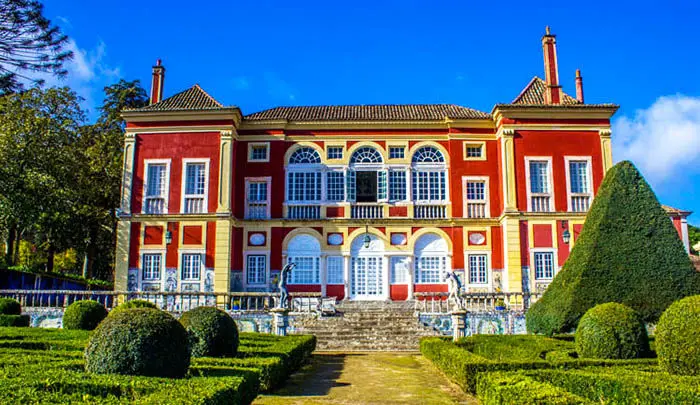
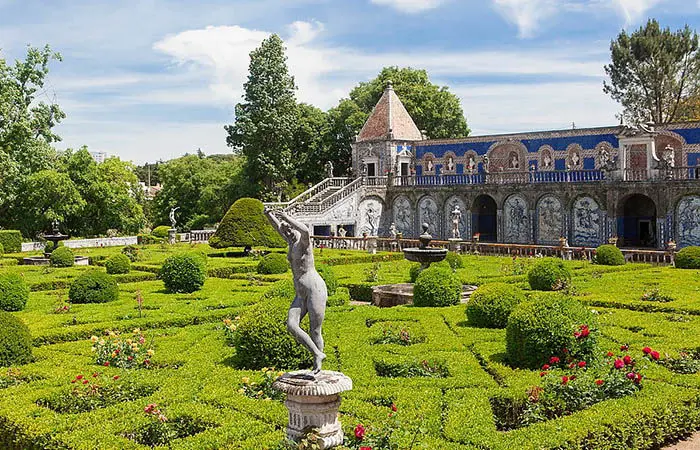
Audio guide devices, Multimedia audio guides,
Audio guide GPS tourist bus-train, charging bases and accessories.
Group guidance systems, headsets, charging cases, tour guide systems accessories.
Audioguides available from mobile devices, web App, downloadable App from Google Store.
Audioguides in several languages, translations, voiceovers. Audio descriptions, signoguides, visual contents for audioguides. 3D Reality.